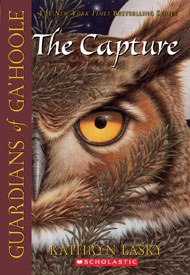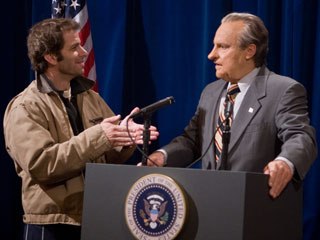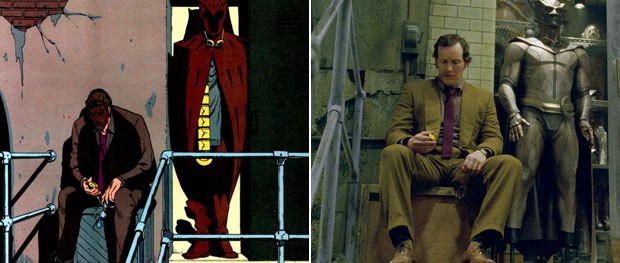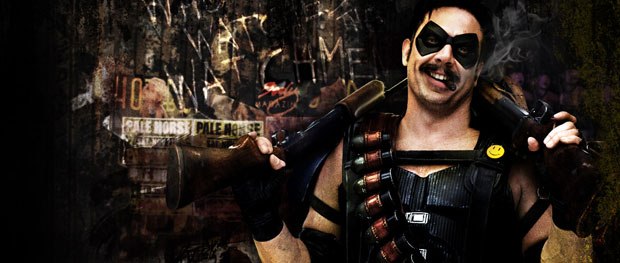After our in-depth making of coverage, the Watchmen director discusses bringing the landmark graphic novel to the screen.
Zack Snyder always knew that making Watchmen was going to be a difficult journey: part fanboy exercise, part artistic indulgence. Yet strict fidelity to the landmark graphic novel was never the goal.
Production Designer Alex McDowell will grant that much. "For Zack, it was really important to hit the 30 images that the fans carry with them from the graphic novel. And for himself: to know that those big beats would be respectful. But we made some big changes in the threads between those. One of the huge contributions Zack made to this -- which will really be apparent when you watch the film -- is that there are layers and layers of pop cultural reference on top of the Watchmen reference and on top of the pop cultural references already embedded in [the graphic novel]," he says. "Because we have the hindsight of 20 years and the knowledge that Apocalypse Now is embedded in the consciousness of the audience, if you want to play "The Ride of the Valkyries" over Vietnam, you've added an entire other reference layer that puts you in another space."
McDowell says they were empowered by Snyder to go deeper and deeper into the pop cultural references and to even add their own, including Taxi Driver, Dr. Strangelove and The Man Who Fell to Earth (whose table tennis room was McDowell's personal contribution to Dr. Manhattan's baroque abode but which did not make the theatrical cut).
"What we were able to do was extract all of that richness from the graphic novel and really put it in… There are all of these Easter Egg clues and I think it's going to be a way of reading this film that is going to last for years: there are clues that are deep, deep, deep within it. It's going to be a frame-by-frame analysis of it."
To begin with, Snyder conjured an ingenious main title sequence that embeds the Watchmen into an alternative history from 1939-1985, which foreshadows the decline of the superheroes along with the rise of social unrest.
"From the very beginning I wanted to do a cool title sequence for the movie and it was actually the thing that got me started drawing Watchmen because they were trying to figure out how much this movie was going to cost," Snyder explains. "And I said it's really impossible to say until I start drawing the movie and get a sense of what the movie is... So, I said, 'Look, to get a handle on some of the things, maybe I'll draw the title sequence so we can see how much that is.' But I literally went to the beginning of the movie and started drawing. It was funny because I had the music -- I was pretty positive that it was going to be Bob Dylan's 'The Times They Are A-Changin'.' And then it started to take shape for me as we really find out where we are in the world, and that's how that sequence came about, tracing the alternate history. There's a bunch that I shot that we didn't use because it got too long like The Comedian raising the flag on Iwo Jima by himself and Nixon being sworn in."
But apart from the design, the cinematography, the visual effects and all of the other intricate technical challenges, Snyder insists that the tone was the hardest part. "I'm obsessed with tone. And I wanted to make a movie that was satirical and also serious at the same time. You want the movie to be self-reflexive but not let the viewer off the hook completely. If you feel like it's a complete satire, then the problems aren't real and they're all manufactured to make a cultural point and it doesn't matter. But if you can make it slightly self-reflexive where there's an idea [that's] not totally in [your] face, then it's trying to break through. We didn't do anything by mistake -- that's the thing that's interesting about Watchmen."
And typical of Snyder, he first storyboarded the entire film, starting with the first shot of the yellow car with the black Warner Bros. logo all the way through to the last shot of Rorschach's journal. "And I'd go back and forth using the graphic novel and the script that I had at the time to mush them all together," the director adds. "You have the idea but when you actually draw it and actually visualize it, it becomes something else. What we intended for every aspect of the production was completely premeditated... Every part of it: the performances, the design of Manhattan, every set, every brick, every piece of graffiti, every poster, the music..."
And what was it like working with McDowell, master of the new workflow paradigm? "It's incredibly helpful when production design and visual effects and physical production are all synched up," Snyder admits. "A lot of times, the visual effects and the set design and physical production are all in their own world and not talking to one another. But these guys were friendly and they used workflows that were similar and they shared assets in a really cool way and it was super helpful."
Of course, when it came time to trimming his theatrical cut to 161 minutes, Snyder admits there were some tough choices to make. The most painful one was cutting the death of Hollis Mason (Stephen McKattie), the original Nite Owl, on Halloween, after he has bonded with Nite Owl II, aka Dan Dreiberg (Patrick Wilson). "Actually, it was easy to take out without destroying the movie. Anything else, when we were at that point, was like a house of cards."
But not to worry: Snyder promises two extended cuts when Watchmen comes to DVD and Blu-ray (in July from Warner Home Video): the director's cut, which runs about three hours and 10 minutes, and the nearly three-and-a-half hour "Black Freighter" cut, which includes the animated story-within-the story that echoes the plight of the Watchmen (streeting March 24 as a standalone DVD and Blu-ray from Warner Home Video).
"'The Black Freighter' cut includes the ins and outs at the newsstand with the two Bernies [with vfx from Rising Sun Pictures], which we shot knowing that it would be on a DVD somewhere and would never make it into the movie," Snyder adds. "We knew that wasn't viable for the marketplace. Look, the movie was excessive enough and I was asking a lot of the studio: as long as they let me finish my cut -- and they did finish the visual effects at the highest level. And they've also talked about doing a short theatrical run of the director's cut in July when [the DVD and Blu-ray] comes out."
Still, Snyder concedes, there were crucial moments that he would not compromise when the studio suggested certain cuts. "And, of course, the funny thing is that when I was getting ready to shoot the movie, we had updated the scripted to equal the storyboards, and they were like, 'We've looked at the script and we feel we've identified three areas where you can cut: The Comedian's funeral, Manhattan goes to Mars -- nothing happens there -- and you don't need to interrogate Rorschach -- you don't need to know anything about his backstory.' I said, 'Look, if you cut out all those things, which you absolutely could do... I would wager a lot that this would just be a plot-driven movie... and this is not the movie I want to make'."

Meanwhile, those three moments "were the most difficult sequences because they were the most abstract... it was intellectually and physically difficult and things that fall out of the usual storytelling rules."
But then this is all about subverting the genre. "The point of the movie is to go on all those tangents in a superhero movie and you either like that or you don't -- but it is what it is. Without that, you might as well as make X-Men or Fantastic Four."
So what has been the impact of Watchmen on Snyder, as he transitions from Owlship to owls in his first animated feature, Guardians of Ga'Hoole (with Animal Logic), and begins prepping Sucker Punch, described as "Alice in Wonderland with machine guns"?
"I had a great experience making the movie and I'm proud of the movie and love it. But maybe because I am a fan of the graphic novel and I wanted it to be such a good movie, I'm pretty happy with it. It's abstract to me now because when you're this deep into it, the shots don't mean anything anymore. No, I didn't change as a filmmaker. It's what's in me. Look, has there ever been a movie made for fanboys as much as this one? Probably not. So they'll either like it or they won't, and [again], it is what it is. [But] they have to acknowledge the custom aspect of this movie."
Bill Desowitz is senior editor of AWN and VFXWorld.













